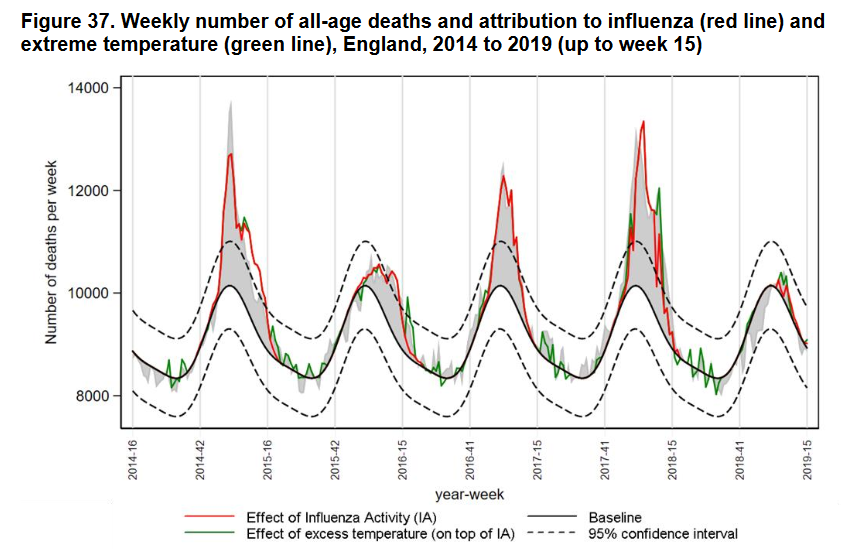
In Britain there are around 600,000 deaths annually. Over the flu seasons 2014/15 to 2017/18 there were an average of approximately 21,000 deaths annually associated with the flu in England.
| Season | All ages | 0-4 years | 5-14 years | 15-64 years | 65+ years |
| 2014/15 | 28,330 | 91 | 13 | 701 | 25,143 |
| 2015/16 | 11,875 | 84 | 11 | 1,259 | 9,459 |
| 2016/17 | 18,009 | 77 | 20 | 578 | 15,167 |
| 2017/18 | 26,408 | 6 | 2 | 1,462 | 22,237 |
Source: Table 7, Surveillance of influenza and other respiratory viruses in the UK (Flu Annual Report) Winter 2018 to 2019
Their figures don't quite add up, but they have 95% confidence intervals of some +/-4%, and the elderly constitute the vast majority as would be expected.
Figure 37 plots the weekly deaths attributed to the flu, and in the 2014/15 and 2017/18 seasons this figure peaked at between 12,000 and 14,000. It can be seen that the peaks, in particular, the greater ones, have very steep slopes. The rate of deaths rises very rapidly, but subsides just as quickly after peaking.

Human coronaviruses (CoV) are responsible for around 10% of viral respiratory infections such as colds and flu, although this proportion varies over time as shown in Figure 1 here.
Compare the flu deaths with the fatalities for the novel coronavirus. Both the daily deaths and the accumulated total from Covid19 were initially increasing exponentially by more than 30% daily, which represents a doubling every two to three days. This corresponds to the very steep sloping increase seen in flu deaths just before the season peaks.
A 30% daily increase amounts to a more than six-fold weekly increase. As the peak approaches, the daily increase declines. A 20% daily increase maintained over a week would lead to a nearly 3.6x increase.
Neil Ferguson is the doom-mongering professor from Imperial College, London, whose team advises the UK government on policy using 'scientific' models that have not been peer-reviewed. He advocates continuing the UK lockdown until June. However, it was Ferguson whose advice to then prime minister Tony Blair in 2001 on the foot and mouth epidemic led to the unnecessary culling of more than six million farm animals.
As of April 5, 2020, even Ferguson predicts that UK deaths are likely to top at no more than between 7,000 and 20,000. This is a very reasonable assumption given the daily total fatality figures of 2,352, 2,921, 3,605, 4,313, 4,934 and then 5,373 for April 1 to 6.
The average daily increase over March 14 to 31, from 21 to 1,789 respectively, was 29.88%, which equates to a doubling every 2 to 3 days. The last few daily increases have been 24.19%, 23.42%, 19.64%, 14.40% and 8.90%. In the UK the 'lockdown' commenced on Tuesday March 24.
For the coronavirus "Covid19", the median time from illness onset to death is 18.5 days, and the median duration from exposure to symptoms onset (incubation period) is 5.1 days. Thus, there is a lag of about 24 days between the introduction of a new "social distancing" policy and its effect upon the daily death rate, and the UK's March 24 'lockdown' measures should have their greatest effect on Friday April 17.
It's actually a little longer than that, since there is also the time taken for the deaths to be reported.
Yet we are already seeing a clear slowing of the increase in fatalities in the first few days of April, within one or two weeks of introduction of the 'lockdown'. No doubt Ferguson and the government will take credit for the slowdown and claim it is due to government policy, and it 'proves' that citizens must accept continuing restrictions on freedom.
More likely, the statistics are exhibiting the same natural topping out as happened in the 2014/15 and 2017/18 seasonal flu outbreaks in the above chart. The flu fatalities were below 30,000 in each of the worst years, and with 12,000 to 14,000 as the weekly peak, the weeks either side of the peak would be significantly down.
It's interesting that Sweden has kept bars, restaurants and even gyms open, and yet its daily coronavirus deaths on April 6 were 76, barely more than 10% up on the 69 who lost their lives four days previously.
There is always a tiny chance that the lockdown supporters are right, and this would be borne out if fatalities continued to increase at around 20% daily, with the increase slowing markedly as we approach April 17. Suppose the average daily increase is 15% from April 5 to April 17. This would lead to an overall increase of approximately 5.35 times to 26,398, which is comparable to a bad year for the flu. And further crashing of the economy in an attempt to mitigate this would be totally irresponsible, saddling future generations with massive debt and high taxes.
However, Ferguson's own estimate of 7,000 to 20,000 is looking increasingly likely. In this case there is no doubt that the policies of economic collapse and recession are far more damaging than any virus could inflict, since many will die from poverty and the resulting lack of funds for the NHS. There is very little case for extending the lockdown beyond three weeks. And an extension until June would be stark, staring bonkers and tantamount to manslaughter.